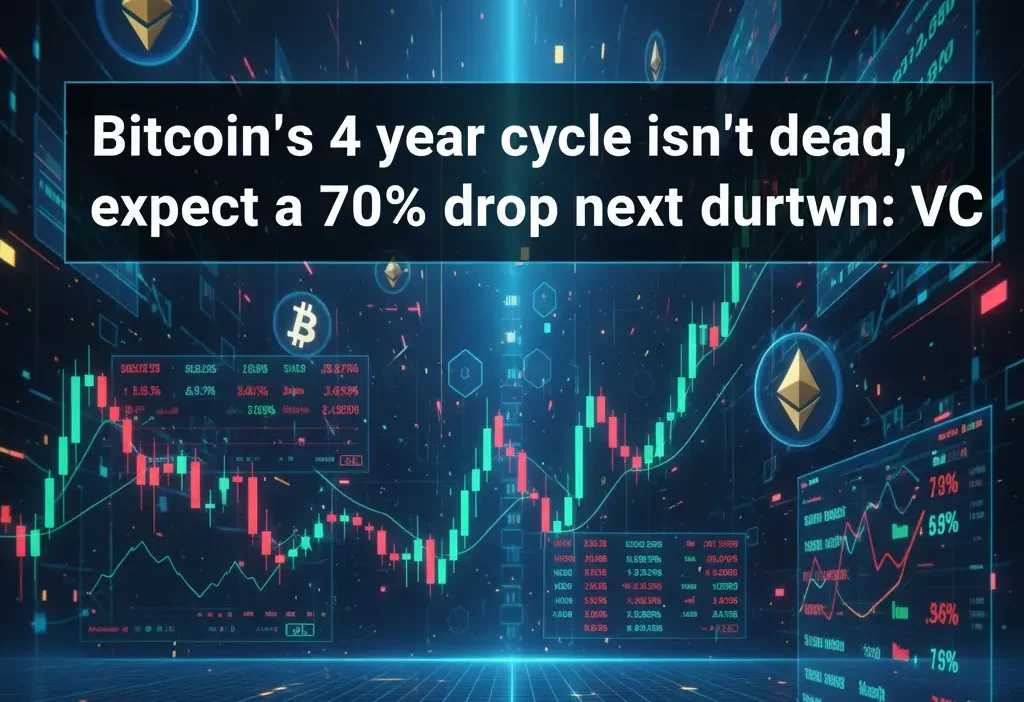Introduction
Vineet Budki, CEO of Sigma Capital, recently told Cointelegraph and other outlets that Bitcoin’s multiyear rhythm remains intact and that the next downturn could produce a 65–70% drawdown from peak levels. His blunt takeaway: many holders don’t fully understand Bitcoin’s economic properties, so when negative signals appear they will sell first — and that dynamic could recreate the deep corrections we’ve seen before. This article explains Budki’s warning, places it in historical context, examines the mechanics that can trigger a steep decline, and gives practical guidance for traders and investors. TradingView
What Budki actually said — the headline explained
At the Global Blockchain Congress 2025 in Dubai, Budki argued the familiar pattern of “boom and bust” is not dead: price cycles driven by adoption, leverage, psychology and macro liquidity have repeated, and he expects another major retracement of roughly 65–70% over the next one to two years. He also reiterated a long-term constructive view — suggesting Bitcoin could still reach much higher prices over a decade — but warned of a painful intermediate correction. Multiple outlets summarized his remarks and the 70% figure shortly after the talk. TradingView
Why the four-year pattern matters
The so-called “four-year cycle” (loosely tied to halving events and liquidity rotations) has framed Bitcoin market psychology for much of its history. Traders and funds reference it when sizing exposure and forecasting drawdowns. Budki’s point is not that timing is exact, but that structurally similar forces — an influx of speculative capital followed by a liquidity reset — persist. Those forces can translate into sharp retracements when sentiment shifts. Historical drawdowns in past cycles often reached deep double-digit percentages, which is why investors still watch the cycle as a risk framework. ForkLog
The mechanics behind a 65–70% retracement
Why would Bitcoin fall so far? Budki’s reasoning rests on three structural drivers:
- Leverage and liquidations — Extreme leverage funnels a small price wobble into cascading liquidations, pushing prices lower and inviting more selling.
- Retail panic — Newer holders, often with higher cost bases, are most likely to sell early when fear rises.
- Lack of broad fundamental knowledge — When the majority hold an asset without understanding its drivers, narrative shifts can produce outsized outflows.
Taken together, these factors can transform a conventional correction into a deep wipeout inside a 4 year cycle reset.
Historical precedent: prior cycles and drawdowns
Look back and you’ll see similar dynamics: the 2013–2015 and 2017–2018 cycles produced brutal retracements (up to ~80% in 2018 from the peak), while the 2021–2022 cycle included a large drawdown near 70% for certain timeframes. Those episodes followed periods of exuberant buying, rising leverage, and then a catalyst (macro shock, regulatory news, or a liquidity event) that flipped sentiment. Budki’s warning rests on that historical symmetry — not as prophecy but as a probabilistic reminder. ForkLog.
On-chain signals that support cyclical risk
On-chain metrics provide a glimpse into holder behavior: exchange inflows/outflows, realized profit and loss, and concentration of supply among large wallets. Elevated inflows to exchanges and a high proportion of short-term holder supply can be early red flags. Budki’s warning maps to these indicators: when on-chain data shows distribution from long-term to short-term holders, the market is more vulnerable to a severe correction inside the 4 year timeline.
Macro context — why broader markets amplify crypto cycles
Bitcoin’s amplitude relative to macro liquidity means that global monetary shifts can worsen cyclical drawdowns. A tightening cycle, higher yields, or sudden risk-off rotation can reduce the marginal buyer pool — exacerbating price declines. Budki’s expectation of a deep drawdown assumes that when sentiment turns, the macro backdrop may not be supportive, and that compounds any 4 year cycle unwind.
The behavioral economy — why panic sells happen first
Behavioral finance explains much of Budki’s thesis. Investors who lack conviction or understanding typically respond to negative news by selling, frequently first. Those who bought during frothy rallies often hold at a loss when prices reverse; their fear of further loss translates to selling pressure. That dynamic — novice holders driving early exits — is a key reason Budki believes a 4 year cycle sell-off could be deeper than many expect.
How likely is a 70% drop from here? (a reality check)
Predicting an exact percentage is inherently uncertain. Budki’s 65–70% figure is a risk scenario — a plausible tail outcome if multiple adverse signals line up. Important moderating points:
- Magnitude depends on peak levels. A 70% drop from an all-time high is larger in absolute dollars than from a lower local high.
- Timing is ambiguous. Budki suggested this could play out within the next two years, not overnight.
- Countervailing forces exist. Spot ETF demand, institutional custody, and growing on-chain use cases can lengthen and stabilize accumulation phases.
So treat the 70% figure as a severe-but-plausible scenario, not an inevitability. CoinMarketCap
Risk management playbook for traders
If you accept the premise that a major 4 year cycle correction is plausible, practical steps matter:
- Trim leverage — near elimination if you have a multi-year horizon.
- Staggered exposure — use phased buys instead of lump sums.
- Protect with options — if available and affordable, collar or buy puts on major positions.
- Watch real-time signals — exchange inflows, funding rates, and derivatives open interest. These metrics often pre-announce liquidation cascades.
- Predefine stop-loss zones and adhere to them to avoid emotional errors once volatility spikes.
These tactics reduce the risk of being forced to sell at the worst moments during a 4 year cycle washout.
Strategy for long-term investors: accumulation vs timing
Long-term investors face a choice: attempt market timing (dangerous) or adopt disciplined accumulation. Budki’s warning is not automatically a bearish endorsement for long-term selling. Instead, he suggests long-horizon investors prepare for deeper entries by building cash reserves and using dollar-cost averaging during periods of weakness. If a 4 year cycle drawdown unfolds, patient capital can materially improve average cost without predicting exact bottoms.
How institutions think about cyclical risk

Institutional allocators often build models for drawdown scenarios before deploying capital. A credible institutional thesis for crypto will include stress tests for 50–70% drawdowns — precisely the range Budki cites. Large funds tend to use liquidation-resistant custody, hedging, and position-sizing rules to survive 4 year cycles; their presence can dampen, but not eliminate, volatility.
Technical charts: levels and targets
From a technical standpoint, a 65–70% drop implies price retests of long-term moving averages and previous accumulation bands. Analysts often map these projections to moving average clusters or Fibonacci retracements. In Budki’s scenario, markets return to deep support zones formed in prior cycles, a classic feature of the 4 year reset where previous highs become future support areas for re-accumulation.
Potential catalysts that could trigger the downturn
Specific events can act as triggers of the next bear leg within a 4 year cycle: a major regulatory crackdown, large-scale margin calls in derivatives markets, a systemic banking shock, or a global macro liquidity drain. While Budki doesn’t predict which catalyst will start the fall, he emphasizes that regardless of the trigger, the market psychology and structure make a deep correction plausible.
The contrarian view — why some investors disagree
Not everyone agrees with the gloomier interpretation. Many proponents argue that improved infrastructure (ETFs, custody, regulation) and broader adoption reduce the probability and depth of future drawdowns. They see institutional flows and product maturation as stabilizing forces that could alter the traditional 4 year pattern into a smoother secular trend. This counterargument highlights an active debate: whether newer market structures have meaningfully changed cycle dynamics.
Opportunity thesis: how to position if you believe Budki
If you accept the Budki thesis as likely, here’s a conservative positioning blueprint:
- Hold a smaller core stake as long-term conviction.
- Keep a dedicated cash reserve to buy during major corrections.
- Use disciplined dollar-cost averaging into major support zones painted by historical cycles.
- Consider hedges (shorts or options) sized to protect the core allocation during the initial shock of a 4 year cycle sell-off.
This approach balances psychological resilience with readiness to act when volatility creates opportunity.
Monitoring checklist — indicators that matter right now
Keep an eye on these metrics to get early warning of a 4 year cycle turning point:
- Derivatives open interest and funding rates — sudden spikes suggest crowded trades.
- Exchange net flows — rising inflows into exchanges often precede price drops.
- Whale transfers — large transfers to exchanges signal distribution.
- Macro stress markers — yield jumps, liquidity tightening, and equity market shocks.
- On-chain sentiment — realized losses ratio and short-term holder concentration.
Acting early on these signals can help you weather the next 4 year retracement.
What a ‘bottoming’ process could look like
A market bottom after a deep 4 year cycle correction typically takes months to form, not days. Expect multiple shakeouts, liquidity tests, and false starts. True recovery often requires renewed on-chain accumulation, falling liquidation risk, and a restoration of broad market confidence. Historically, patient holders who accumulate during this grinding process are best positioned for the subsequent bull phase.
Psychological preparedness — surviving a deep drawdown
Fear management is as important as portfolio design. Prepare mentally for steep, repeated losses and avoid forced reactions. Commit to a plan — whether it’s phased accumulation, fixed rebalancing, or rules for hedging — and follow it. Recognizing that 4 year cycles produce emotional whiplash helps you avoid panic selling at the worst moments.
Final view — balancing realism with long-term optimism
Vineet Budki’s call for a potential 65–70% correction inside the next 4 year cycle is a sobering reminder that volatility is inherent to crypto markets. It’s also a reminder that deep retracements are part of the maturation process. For prudent investors, understanding cycle dynamics and having a plan beats short-term forecasts. The market can be unforgiving in the moment but generous over long horizons — if you survive the storm.
Scenario planning — three concrete paths
- Soft reset: A 20–40% pullback that shakes out weak hands but leaves the core growth thesis intact.
- Deep retracement (Budki scenario): 65–70% decline driven by cascading liquidations and institutional outflows — painful but not terminal for long-term adoption. TradingView
- Disrupted transition: Policy or systemic banking shocks cause extended market dysfunction and a multi-year drawdown — worst case for many participants.
Plan for each path by sizing positions and liquidity accordingly.
Disclaimer
This article is for informational purposes only and does not constitute financial advice. Cryptocurrency investments are highly volatile and may result in significant or total loss of capital. Always conduct your own research and consult a licensed financial advisor before making any investment decisions. Do at your own risk.
Conclusion
Vineet Budki’s warning — that the familiar multiyear Bitcoin rhythm could produce a 65–70% retracement — is a sober reminder that large drawdowns are part of crypto’s history. Whether you view that as a risk to avoid or an opportunity to prepare for, the prudent course is the same: reduce unnecessary leverage, codify a plan for multiple scenarios, and use on-chain + derivatives data to stay ahead of rapid regime changes. The Bitcoin cycle has produced both dramatic gains and dramatic losses; respecting its force is the first step to surviving the next major move. TradingView
Author Review
Author: Ali hamza




